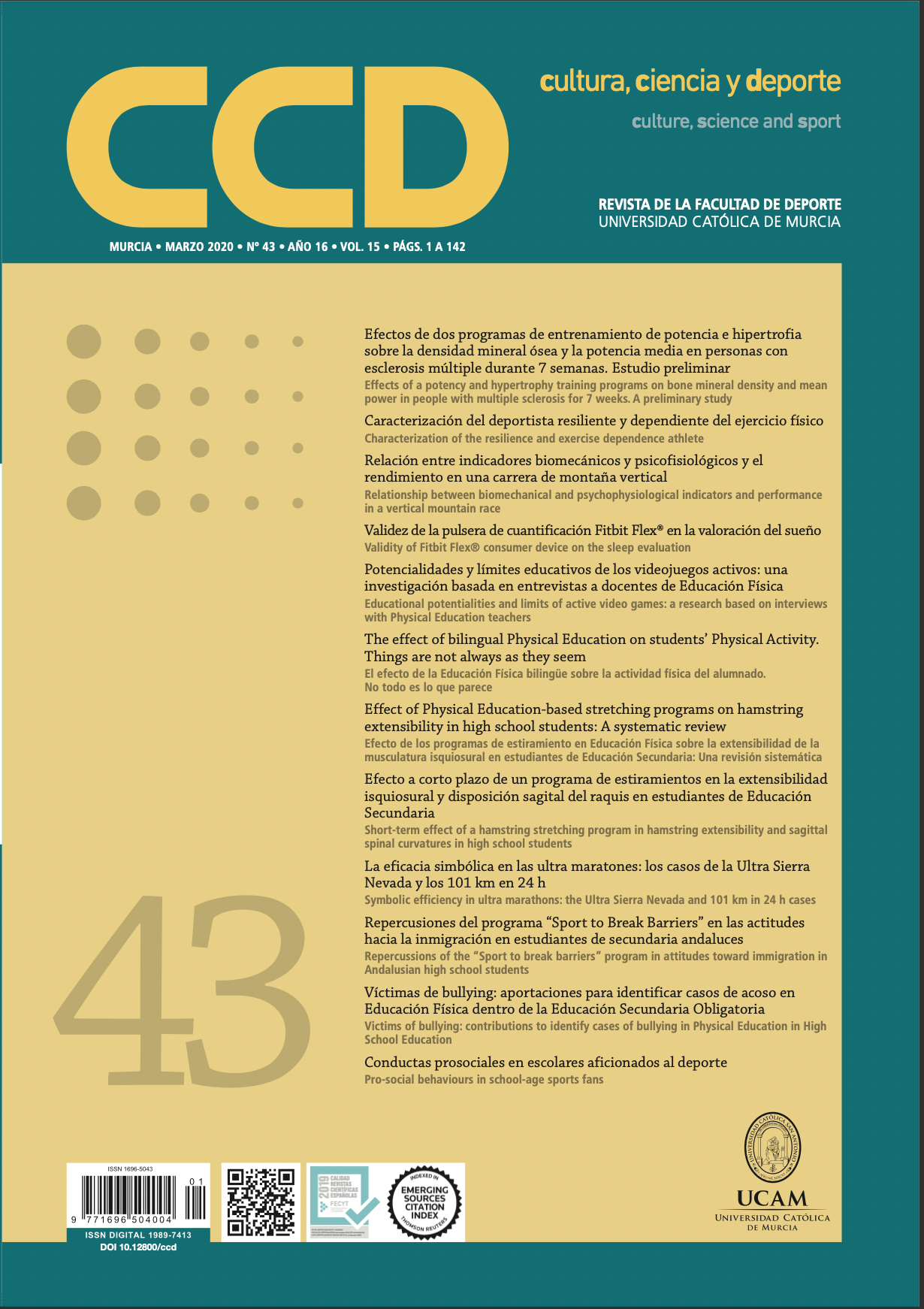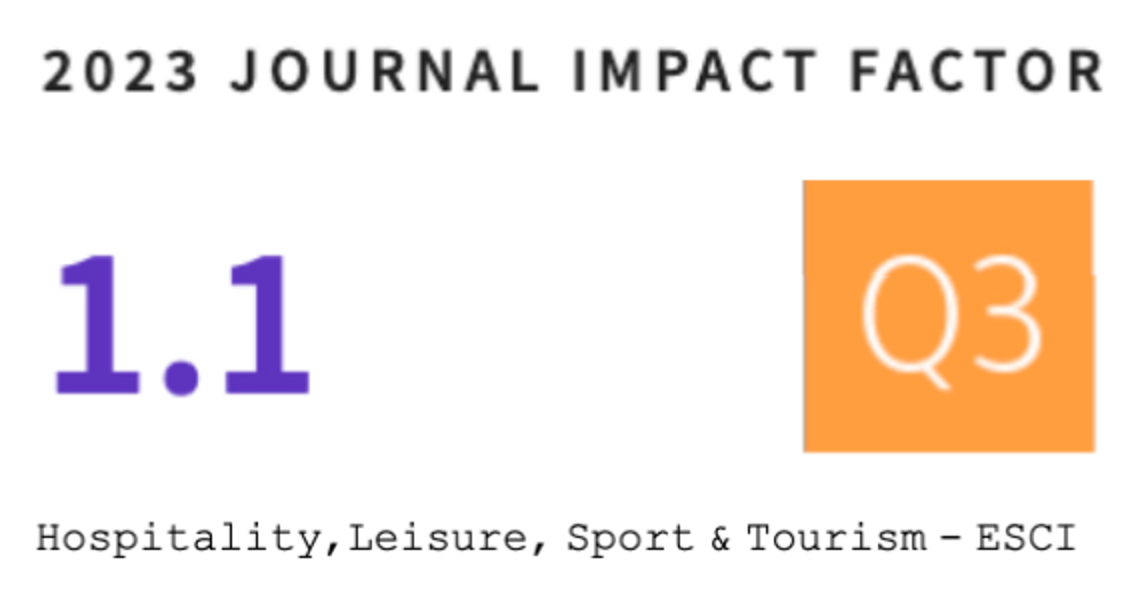The effect of bilingual Physical Education on students’ Physical Activity. Things are not always as they seem. (El efecto de la Educación Física bilingüe sobre la actividad física del alumnado. No todo es lo que parece).
DOI:
https://doi.org/10.12800/ccd.v15i43.1407Keywords:
Physical Education, CLIL, Physical Activity, Accelerometers, Approach.Abstract
One of the priorities of ET2020 is to increase the efficiency of teaching through the Content and Language Integrated Learning (CLIL) approach. In Physical Education (PE), it is still not crystal clear whether sessions that involve CLIL undergo such substantial modifications that the amount of physical activity in the lessons is jeopardized when compared with ordinary Physical Education lessons. The objectives of this study were: (1) to determine the difference in Moderate to Vigorous Physical Activity (MVPA) between a CLIL and a non-CLIL group; (2) to analyse the progression of MVPA during a PE unit; (3) to analyse the possible differences in MVPA between males and females. A quasi-experimental design was implemented. The sample consisted of 48 from a Spanish secondary school, divided into a CLIL group and a non-CLIL group. GENEActiv Accelerometers were used to objectively measure their MVPA. The results showed significant differences in favour of the CLIL group, whose average MVPA was higher than that of the non-CLIL group. In conclusion, the results suggest that CLIL may be a valid approach to use in PE without compromising students’ physical activity.
===
Una prioridad del ET2020 es incrementar la eficiencia de la enseñanza mediante el Aprendizaje Integrado de Contenidos y Lenguas Extranjeras (AICLE). En Educación Física (EF) aún no parece claro si las sesiones mediante AICLE se ven tan modificadas como para alterar significativamente la cantidad de actividad física del alumnado en comparación con clases ordinarias. Los objetivos de este estudio fueron: (1) determinar la diferencia de Actividad Física Moderada-Vigorosa (AFMV) entre un grupo AICLE y otro no-AICLE; (2) analizar la progresión de AFMV durante una unidad de EF; (3) analizar las posibles diferencias en AFMV entre chicos y chicas. Se utilizó un diseño cuasi-experimental. La muestra estaba compuesta por 48 estudiantes de un instituto de educación secundaria español, divididos en un grupo AICLE y otro no-AICLE. Para medir objetivamente los niveles de AFMV se utilizaron acelerómetros GENEActiv. Los resultados indicaron diferencias significativas a favor del grupo AICLE, cuya media de AFMV fue mayor que la del grupo no-AICLE. En conclusión, los resultados apuntan a que AICLE podría ser un enfoque válido en EF, puesto que no necesariamente pone en riesgo la actividad física del alumnado.References
Aelterman, N., Vansteenkiste, M., Van Keer, H., Van den Berghe, L., De Meyer, J., & Haerens, L. (2012). Students’ objectively measured physical activity levels and engagement as a function of between-class and between-student differences in motivation toward physical education. Journal of Sport and Exercise Psychology, 34(4), 457-480. doi: 10.1123/jsep.34.4.457
Ayuso, J. A. Z., Rivero, M. D. G., & Izquierdo, A. C. (2018). El modelo competencial en educación física: Contribución, evaluación y vinculación con sus contenidos. Cultura, Ciencia y Deporte, 13(37), 17-30. doi: 10.12800/ccd.v13i37.1035
Baena, A., & Granero, A. (2015). Versión española del sport satisfaction instrument (SSI) adaptado al aprendizaje de la educación física bilingüe en inglés [Spanish version of the sport satisfaction instrument (SSI) adapted to learning bilinligual in English physical ducation]. Porta Linguarum: Revista Internacional de Didáctica de las Lenguas Extranjeras, 24, 63-76. doi: 10.1387/Rev.Psicodidac.4037
Ball, P. (2009). Does CLIL work? In D. Hill & A. Pulverness (Eds.), The best of both worlds (pp. 32-43). Norwich: Norwich Institute for Language Education. Brooke, M. (2015). A completely different ball game: Content and language integrated learning through the sociology of sport. ELTWorldOnline.com, 1-23. Retrieved from http://blog.nus.edu.sg/eltwo/?p=4799
Calahorro, F., Torres-Luque, G., López-Fernández, I., Santos-Lozano, A., Garatachea, N., & Álvarez, E. (2015). Actividad física y acelerometría; orientaciones metodológicas, recomendaciones y patrones [Physical activity and accelerometer: Methodological training, recommendations and movement patterns in school]. Nutrición Hospitalaria, 31(1), 115-128. doi:10.3305/nh.2015.31.1.7450
Campbell, D.T., & Stanley, J.C. (1963). Experimental and quasi-experimental designs for research. Reprinted from N.L. Gage (Ed.), Handbook of research on teaching. Boston: Rand McNally. Ceallaigh, T. Ó., Mhurchú, S. N., & Chróinín, D. N. (2017). Balancing content and language in CLIL. Journal of Immersion and Content-Based Language Education, 5(1), 58-86. doi:10.1075/jicb.5.1.03oce
Cenoz, J., Genesee, F., & Gorter, D. (2014). Critical analysis of CLIL: Taking stock and looking forward. Applied Linguistics, 35(3), 243-262. doi:10.1093/applin/amt011 Chiva, O., & Salvador, C. (2016). Aprendizaje integrado de educación física y lengua inglesa. Aplicación crítico-deliberativa del método AICLE. Barcelona: INDE.
Clark, A. (1995). Boys into modern languages: An investigation of the discrepancy in attitudes and performance between boys and girls in modern languages. Gender and Education, 7(3), 315-326. doi:10.1080/09540259550039022
Coral, J. (2010). L’aprenetatge de l’anglès a través de l’educació física: El programa “mou-te i aprèn. Temps d’educació, 39, 149-170. Retrieved from https://ddd.uab.cat/record/117840
Coral, J. (2012). Aprenentatge integrat de continguts d’educació física i llengua anglesa: educació física en AICLE al cicle superior de primària. (Tesis doctoral). Universitat de Barcelona: Barcelona. Retrieved from http://hdl.handle.net/2445/43177
Coral, J. (2013). Physical education and English integrated learning: How school teachers can develop PE-in-CLIL Programmes. Temps d’Educació 45, 41-64. Retrieved from http://www.raco.cat/index.php/ TempsEducacio/article/view/274633
Coral, J., & Lleixà, T. (2016). Physical education in content and language integrated learning: successful interaction between physical education and English as a foreign language. International Journal of Bilingual Education and Bilingualism, 19(1), 108-126. doi:10.1080/136700 50.2014.977766
Coral, J., Lleixà, T., & Ventura. C. (2016). Foreign language competence and content and language integrated learning in multilingual schools in Catalonia: an ex post facto study analysing the results of state key competences testing. International Journal of Bilingual Education and Bilingualism. Advance online publication. doi: 10.1080/13670050.2016.1143445
Coral, J., Urbiola, M., Sabaté, E., Bofill, J., Lleixà, T., & Vilà Baños, R. (2017). Does the teaching of physical education in a foreign language jeopardise children’s physical activity time? A pilot study. International Journal of Bilingual Education and Bilingualism. Advance online publication. doi:10.1080/13670050.2017.1407289
Coyle, D., Hood, P., & Marsh, D. (2010). CLIL. Cambridge: CUP. Cross, R. (2014). Defining content and language integrated learning for languages education in Australia. Babel, 49(2), 4-15. Retrieved from http://hdl.handle.net/11343/56569
Dalton-Puffer, C. (2011). Content-and-language integrated learning: From practice to principles?. Annual Review of Applied Linguistics, 31, 182-204. doi:10.1017/S0267190511000092 Dodd, G. D. (2015). The unrealised value of human motion–‘moving back to movement!’. Asia-Pacific Journal of Health, Sport and Physical Education, 6(2), 191-213. doi:10.1080/18377122.2015.1054149
Doiz, A., Lasagabaster, D., & Sierra, M. (2014). CLIL and motivation: The effect of individual and contextual variables. The Language Learning Journal, 42(2), 209-224. doi:10.1080/09571736.2014.889508
Emmanouilidou, K., & Laskaridou, C. (2017). Physical education through CLIL: Teaching movement vocabulary to young learners. Research Papers in Language Teaching and Learning, 8(1), 51-62. Retrieved from http://rpltl.eap.gr
Esliger, D. W., Rowlands, A. V., Hurst, T. L., Catt, M., Murray, P., & Eston, R. G. (2011). Validation of the GENEA Accelerometer. Medicine & Science in Sports & Exercise, 43(6), 1085-1093. doi:10.1249/ MSS.0b013e31820513be
Fairclough, S., & Stratton, G. (2005). Physical activity levels in middle and high school physical education: A review. Pediatric Exercise Science, 17(3), 217-236. doi:10.1123/pes.17.3.217
Fairclough, S., Noonan, R., Rowlands, A., Van Hees, V., Knowles, Z., & Boddy, L. (2016). Wear compliance and activity in children wearing wrist and hip mounted accelerometers. Medicine & Science in Sports & Exercise, 48(2), 245-253. doi:10.1249/MSS.0000000000000771
Fernández-Barrionuevo, E. (2017). Generalización de la motivación en aicle entre los dominios de educación física y aprendizaje en lengua extranjera en centros bilingües andaluces (Doctoral dissertation). Universidad de Granada: Granada. Retrieved from http://hdl.handle. net/10481/45493
Fröberg, A., Raustorp, A., Pagels, P., Larsson, C., & Boldemann, C. (2017). Levels of physical activity during physical education lessons in Sweden. Acta Paediatrica, 106(1), 135-141. doi:10.1111/apa.13551
Gill, M., Chan-Golston, A. M., Rice, L. N., Cole, B. L., Koniak-Griffin, D., & Prelip, M. L. (2016). Consistency of moderate to vigorous physical activity in middle school physical education. Family & Community Health, 39(4), 283-292. doi:10.1097/FCH.0000000000000115
Ginciene, G., & Matthiesen, S. Q. (2017). The sport education model on the teaching of track and field in school. Movimento, 23(2), 729-742. doi:10.22456/1982-8918.69788
Gómez, C.L., & Jimenez, M. (2012). The physical educator as a language teacher for English language learners. Strategies, 25(4), 14-17. doi:10. 1080/08924562.2012.10592157
Griva, E., & Kasvikis, K. (2015). CLIL in primary education: Possibilities and challenges for developing L2/FL skills, history understanding and cultural awareness. In Ν. Bakić-Mirić & D. Erkinovich Gaipov (Eds.) Current trends and issues in higher education: an international dialogue. Cambridge, UK: Cambridge Scholars.
Gruber, K. (2015). Improving students’ foreign language competence through Content and Language Integrated Learning (CLIL) in Physical Education (Doctoral dissertation). Wien University: Vienna. Retrieved from urn:nbn:at:at-ubw:1-30452.59277.718264-2
Viciana Ramírez, J., Mayorga-Vega, D., & Mompeán Campillo, M. (2016). Cumplimiento de los estándares curriculares de condición física-salud en educación física. Estudio de la planificación en la formación inicial. Cultura, Ciencia y Deporte, 11(32), 87-95. doi: 10.12800/ccd. v11i32.709
Yang, W. (2015). Content and language integrated learning next in Asia: Evidence of learners’ achievement in CLIL education from a Taiwan tertiary degree programme. International Journal of Bilingual Education and Bilingualism, 18(4), 361-382. doi:10.1080/13670050.2014.9 04840
Zindler, K. (2013). Content and language integrated learning (CLIL) and PE in England. An Exploratory Study (Doctoral dissertation). University of Sheffield: Sheffield. Retrieved from http://etheses.whiterose.ac.uk/ id/eprint/5522
Downloads
How to Cite
Issue
Section
License
The authors who publish in this journal agree with the following terms:
- The authors retain the copyright and guarantee the journal the right to be the first publication of the work as well as licensed under a Creative Commons Attribution License that allows others to share the work with recognition of the authorship of the work and the initial publication in this journal.
















